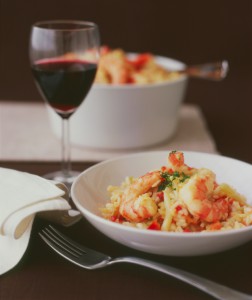Whether we refer to this great varietal as Shiraz or Syrah, we are talking about one of the world’s most illustrious red grape varieties. It is also one of my personal favorites. Grown for centuries in the Rhone Valley of France, where it is responsible in all or part of many of the greatest red wines of France (Hermitage and Châteauneuf-du-Pape specifically), the exact origin of this full-flavored varietal remains in debate. However, historians do agree that it was brought to Europe from the Middle East, but when and by whom remains a mystery.
Some historians maintain that it was the Crusaders, who first brought Syrah to France, while others point to the earlier Roman legions under Probes, and yet others claim it was the remnants of Alexander the Great’s army on its return from Persia. The latter theory is particularly intriguing since Alexander himself was so enamored of the rich, powerful wines he found around the city of Shiraz in Central Persia, that he insisted on staying there, apparently far longer than he should have, since that is where he met his end. Nonetheless, the one point that has been ascertained that everyone seems to agree upon is that the name Shiraz, from the Persian city of that name, is the origin of the varietal’s name. The grape’s name changed to Syrah as it traveled west. In any case, Syrah flourishes today not only in the south of France but in other Mediterranean climates. It fares particularly well in Australia, California, and South Africa, where it is often called by its original name – Shiraz. Australia’s Barossa Valley, South Africa’s Western Cape and several appellations throughout California produce a bevy of lush, polished Syrah/Shiraz wines that are not to be missed.
A Votre Santé!
Don


 increasingly well made with little or no oak. They drink well on their own, so they make excellent aperitifs, and they can double as unobtrusive accompaniments to seafood and light pastas at any time of year. Moreover, they are what I like to refer to as “no headache wines.” Without massive amounts of alcohol or layers of new oak, they are easy on my head as well as my palate. No wonder these wines are increasingly popular in Europe as well as America. Gavi from the Piedmont, Orvieto from Umbria, Verdicchio from a hand full of premium Verdicchio producers in the Marches, and Vernaccia from Tuscany are just a few of the Italian white wines I have especially enjoyed recently.
increasingly well made with little or no oak. They drink well on their own, so they make excellent aperitifs, and they can double as unobtrusive accompaniments to seafood and light pastas at any time of year. Moreover, they are what I like to refer to as “no headache wines.” Without massive amounts of alcohol or layers of new oak, they are easy on my head as well as my palate. No wonder these wines are increasingly popular in Europe as well as America. Gavi from the Piedmont, Orvieto from Umbria, Verdicchio from a hand full of premium Verdicchio producers in the Marches, and Vernaccia from Tuscany are just a few of the Italian white wines I have especially enjoyed recently.